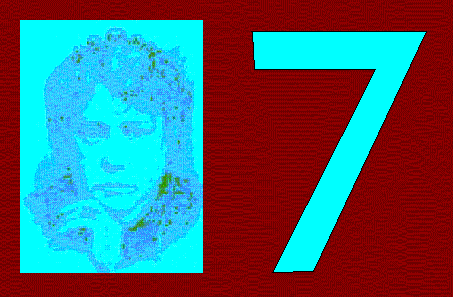Theosophy and the Number
Seven

A selection of articles
relating to the esoteric
significance
of the Number 7 in Theosophy
The Septenary Nature
of Man
An extract from The Key To Theosophy
By
H P Blavatsky
Q. Is it what we call Spirit and Soul, and the man of flesh?
A. It is not. That is the old Platonic division. Plato was an
Initiate, and
therefore could not
go into forbidden details; but he who is acquainted with the
archaic doctrine
finds the seven in Plato's various combinations of Soul and
Spirit. He
regarded man as constituted of two parts-one eternal, formed of the
same essence
as the Absoluteness, the other mortal and corruptible, deriving its
constituent parts
from theminor "created" Gods. Man is
composed, he shows, of
(1) A mortal body,
(2) An immortal principle,
(3) A "separate mortal kind of Soul." It is that which
we respectively call the physical man, the Spiritual Soul or Spirit, and the
animal Soul (the Nous and psuche).
This is the division adopted by Paul, another Initiate, who
maintains that there is a psychical body which is sown in the corruptible
(astral soul or body), and a spiritual body that is raised in incorruptible
substance. Even James corroborates the same by saying that the
"wisdom" (of our lower soul) descendeth not
from the above, but is terrestrial ("psychical,"
"demoniacal," see the Greek text) while the other is heavenly wisdom.
Now so plain is it that Plato and even Pythagoras, while speaking but of three
principles, give them seven separate functions, in their various combinations, that if we contrast our teachings this will
become quite plain. Let us take a cursory view of these seven aspects by
drawing two tables.
Theosophical Division of the Lower Quaternary
Sanskrit Term Exoteric Meaning Explanation
1.Rupa, or Sthula-sarira Physical body Is the vehicle of all the
other
principles during life.
1.Prana Life, or
Vital principle Necessary only to a, c,
d, and the
functions of the lower Manas, which
embrace all those
limited to the (physical) brain.
(c) Linga- sarira
Astral Body The Double,the
phantom body.
(d) Kamarupa The seat of animal desires and passions This is the center of the
animal man, where
lies the line of demarcation which separates the mortal man
from the
immortal entity.
Theosophical Division of the Upper Imperishable Triad
Sanskrit Term Exoteric Meaning Explanation
(e) Manas-a dual principle in its functions. Mind, Intelligence:
which is the
higher human
mind, whose light, or radiation links the Monad, for the lifetime,
to the
mortal man. The future state and the Karmic destiny of man depend on
whether Manas
gravitates more downward to Kamarupa, the seat of the animal
passions, or
upwards to Buddhi, the SpiritualEgo. In the later
case, the higher
consciousness of the
individual Spiritual aspirations of mind (Manas),
assimilating Buddhi,
are absorbed by it and form the Ego, which goes into
Devachanic bliss.
(f) Buddhi The Spiritual Soul The
vehicle of pure universal spirit.
(g) Atma Spirit One with the Absolute, as its radiation.
In Mr. Sinnett's Esoteric Buddhism d,
e, and f, are respectively called the
Animal, the Human, and the
Spiritual Souls, which answers as well. Though the
principles in
Esoteric Buddhism are numbered, this is, strictly speaking,
useless. The dual
Monad alone ( Atma-Buddhi) is susceptible of being
thought of as the two highest numbers (the sixth and seventh). As to all
others, since that
principle only
which is predominant in man has to be considered as the first and
foremost, no
numeration is possible as a general rule. In some men it is the
higher
Intelligence (Manas or the fifth) which dominates the rest; in others the
Animal Soul (Kamarupa) that reigns
supreme, exhibiting the most bestial
instincts, etc.
Now what does Plato teach? He speaks of the interiorman
as constituted of two
parts-one
immutable and always the same, formed of the same substance as Deity, and the
other mortal and corruptible. These "two parts" are found in our
upper Triad, and the lower Quaternary (see table above, ).
He explains that when the Soul, psuche, "allies
herself to the Nous (divine spirit or substance *)),
she
does
everything aright and felicitously;" but the case is otherwise when she
attaches herself
to Anoia, (folly, or the irrational animal Soul).
Here, then,
we have
Manas(or the Soul in general) in its two aspects: when attaching itself
to Anoia (our Kamarupa, or the "Animal Soul" in
Esoteric Buddhism) it runs
towards entire
annihilation, as far as the personal Ego is concerned; when
allying itself to
the Nous ( Atma-Buddhi) it merges into the immortal,
imperishable Ego, and
then its spiritual consciousness of the personal thatwas,
becomes immortal.
*)
Buddhi is meant then and notAtma;
philosophically speaking this (Atma) cannot be called 'substance'. We count
Atma as a human 'principle' in order to not create yet more confusion. In
reality it is not a 'human' but the universal absolute
principle of which buddhi, the soul-spirit, is the vehicle. [reversely
translated note from
Dutch translation - editor]
Theosophical Society, Cardiff Lodge,
Cardiff Lodge’s Instant Guide to Theosophy
Cardiff Lodge’s Gallery of Great Theosophists